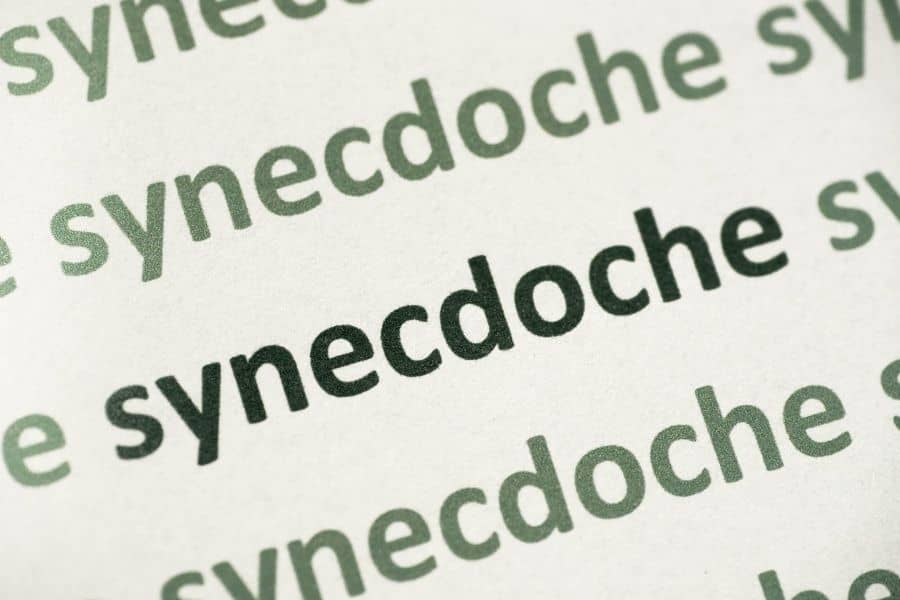In this post, we’ll dive into a hearty collection of synecdoche examples.
And along the way, you’ll learn exactly what synecdoche is, why it’s used, and how it can take your writing from zero to hero.
So, let’s dissect this strange-sounding literary device and then see what it looks like in action.
Onward!

What is Synecdoche?
Synecdoche (pronounced sin-nek-duh-kee) is a literary term that uses a part of something to represent a whole or a whole to represent a part.
Generally, synecdoche is broken into two types: microcosm and macrocosm:
- Microcosm uses a part or element to represent a larger whole, and
- Macrocosm does the opposite: using a whole or larger entity to represent a specific part.
Synecdoche vs. Metonymy
The line between synecdoche and metonymy is a little fuzzy, and you’ll see why after we define metonymy:
Metonymy is a literary term where a word or phrase is substituted with another related word or phrase.
For example:
“We need boots on the ground as quickly as possible”
Where boots (something soldiers typically wear) represent soldiers.
Now let’s look at an example that tip-toes the line between synecdoche and metonymy:
“He asked for her hand in marriage.”
At first glance, it seems obvious that hand is being used to represent the whole woman, in which case we’re looking at synecdoche.
But since the woman’s hand will bear the wedding ring, you could also argue that her hand, in this case, serves as a proximate substitute for her consent to marry him, which would make this an example of metonymy.
Don’t sweat it if you’re still a little fuzzy on the difference between these two literary terms; they confuse most people in the beginning. But to help you get more comfortable with synecdoche, we’ll review a lot more super-fun examples.
Let’s explore some synecdoche examples, shall we?
Forms of Synecdoche with Examples

When a Part Represents a Whole
Microcosmic synecdoche uses a specific part of something to signify the whole object, as you’ll see in the following examples:
- “All hands on deck!” — uses “hands” to signify the whole sailors.
- “I need a headcount by morning,” — uses “head” to represent a whole person.
- “Nice wheels!” — uses “wheels” to designate a whole car.
When a Material Represents an Object
Another type of microcosmic synecdoche references an object using the material of which it’s made, which becomes part of its essence — even when different materials are used to make the same thing.
- “Paper or plastic?” — Both materials are used to make disposable grocery bags, which is what we’re referencing here.
- “Are we out of clean silverware?” — uses silverware to represent the larger class of eating utensils or cutlery, even though most of these aren’t actually made of silver.
- “It’s in the papers” — uses “papers” to mean a newspaper, even if a particular article was found online.
When a Specific Class Represents a Whole
A third category of microcosmic synecdoche involves the use of a specific class or brand name to represent the broader class to which it belongs.
- “We need more Kleenex.” — uses the famous brand name, Kleenex, to represent the larger category of facial tissues in general.
- “I need a Band-Aid”— uses the brand name, Band-Aid, to represent the whole class of adhesive bandages.
- “I hate when they use Styrofoam!” — using Styrofoam, which is a brand name, for polystyrene packing material.
When a Whole Represents a Part
Synecdoche that uses a whole to represent a smaller part is macrosomic.
Let’s look at some straightforward examples:
- “It’s a cruel world” — uses “world” to mean specific people (in a particular setting) who are being jerks. “A cruel world” may also reference an unenjoyable experience.
- “Let’s go to the movies!” — uses “movies” to mean a specific movie playing at a local theater.
- “Forbes wants to interview me! — uses Forbes Magazine to represent the individual reporter who will be doing the interview.
When a Container Represents What it Contains
In another example of macrocosmic synecdoche, the name of a container is used to represent its contents:
- “Can you believe they’re charging ten dollars a glass?” — The “glass” here isn’t referring to the container itself but to the beverage it holds.
- “They ate three whole boxes” — using “boxes” to mean whatever they originally contained.
- “I thought she’d go back to the bottle, but she proved me wrong” — where “bottle” represents alcoholic beverages.
When a Category Represents Items in that Category
And finally, this type of macrocosmic synecdoche uses a category as a type of container to mean a specific item that belongs to it.
- “America took home gold” — uses America as a larger category to represent Olympians for the U.S. team.
- “Denver beat New York in last night’s game” — uses the names of specific states to represent their sports teams.
- “All his enemies were put to the sword” — uses “sword” to represent all methods of execution, which can certainly include the stabby kinds.
20 More Examples of Synecdoche

Now that you know the different forms of synecdoche, you’ll know how to spot them in anything you read, watch, or listen to.
You’ll find some familiar examples below, some of which are more obvious than others.
Examples of Synecdoche in Character Names
It’s not unusual to see synecdoche in character names, and below is just a sampling. You can probably think of others.
- Fang — Hagrid’s dog from the Harry Potter series
- Red — Ellis Boyd Redding from The Shawshank Redemption
- Hot Lips — Margaret Houlihan from the TV series Mash
- Blackbeard — famous seafaring pirate
- Whiskers — cat from Toy Story
Examples of Synecdoche in Literature
Literature — both poetry and prose — both reflects and adds to the use of rhetorical devices in everyday speech, as you’ll see in the following examples:
I heard a Fly buzz—when I died by Emily Dickinson
“I heard a Fly buzz — when I died — The Stillness in the Room
Was like the Stillness in the Air —
Between the Heaves of Storm —
The Eyes around — had wrung them dry —
And Breaths were gathering firm
For that last Onset — when the King
Be witnessed — in the Room —”
Here, ”the eyes” are the people surrounding the speaker as she lay dying.
The Great Gatsby by F. Scott Fitzgerald
“It was the kind of voice that the ear follows up and down, as if each speech is an arrangement of notes that will never be played again.”
In this, ”ear” represents entire people enchanted by the voice the author is describing.
The Rime of the Ancient Mariner” by Samuel Taylor Coleridge
“The western wave was all a-flame.
The day was well nigh done!
Almost upon the western wave
Rested the broad bright Sun.”
Here, “wave” stands in for the ocean.
The Three Musketeers by Alexandre Dumas
“He shall think differently,” the musketeer threatened, “When he feels the point of my steel.”
“Steel” refers to one of the musketeer’s swords, referencing the material it’s made from.
Macbeth by William Shakespeare
“Take thy face hence!”
In this, King Macbeth is demanding one of his servants leave. “Face” is a referring to the servant’s general presence.
Not to get all word nerd here, but this is a brilliant use of synecdoche because face-to-face communication is largely done with, well, the face.
And summing up one’s entire presence as a “face” not only adds dramatic flair, but it feels rather insulting too.
Synecdoche Examples in Conversation & Everyday Language

Synecdoche in everyday speech is generally (though not always) more convenient than poetic.
Let’s look at a few common examples:
- “He’s the brains of the operation” — using brains to represent a whole person whose intelligence is critical to the operation’s success.
- “Let’s give the cast a hand for that stirring performance” — where hand represents the act of hand-clapping or applause to show appreciation.
- “You have my whole heart” — using “heart” to represent your whole person: heart, mind, body, and soul.
Examples of Synecdoche in Pop Culture
You’ll find synecdoche in pop culture references woven into the latest movies, novels, TV series, books, and blog posts.
Here are a few of our favorites:
- “You want a Coke?” — using a popular brand name (subtype) to mean a can or bottle of cola, representing a larger beverage category;
- “Speak truth to power” — where power represents the people who have the power to change things (ideally for the better).
Here’s an example of microcosmic synecdoche in Taylor Swift’s “Our Song,” where “our song” represents memorable and emotional moments shared throughout a romantic relationship:
“Our song is a slamming screen door,
Sneaking out late tapping on your window,
When we’re on the phone and you talk real slow,
‘Cause it’s late and your mama don’t know…”.
Other Famous Examples of Synecdoche
Some expressions stay with us for centuries, whether they come from religious texts, classic literature, or famous personalities throughout history. Here are a few examples:
- “Friends, Romans, countrymen, lend me your ears” — (Julius Caesar, Shakespeare) where “ears” can represent the whole person or the person’s full attention, for which ears and/or other senses are needed.
- “I should have been a pair of ragged claws / Scuttling across the floors of silient seas” — (The Love Song of J Alfred Prufrock, TS Eliot) where “ragged claws” represents worthlessness.
- “Give us this day our daily bread…” — (New Testament) where bread signifies all that the supplicant needs to get through the day.
- “Another day, another dollar” — where dollar (hopefully) represents enough dollars to justify getting out of bed.
Why Use Synecdoche in Writing
Writers use synecdoche for the following reasons:
- To evoke vivid imagery in their readers — because the more senses involved, the longer something dwells in your memory.
- To create connections between complex ideas, which engages the memory and makes the words more meaningful.
The more of your reader’s mind you engage with your creative writing, the longer it will live in your reader’s memory.
That’s what makes this a poetic device:
Because it takes something familiar and does something unexpected with it to get the reader’s attention.
Which examples caught yours?
How Will These Synecdoche Examples Change Your Writing?
Now that you know what synecdoche is, and have experienced a whirlwind tour of 38 synecdoche examples, what stood out for you?
When have you used synecdoche in your own creative writing?
If nothing comes to mind, no worries. Chances are, you’ve used it plenty of times, even if you don’t remember.
That said, we invite you to consciously apply what you’ve learned here by writing some synecdoche examples of your own. These could be bits of dialogue, part of a new blog post, or a social media post.
What will you try first?




Sarah, now I will definitely use synecdoche in my own blogs. Thanks for sharing this and helping out your fellow writers.
Awesome, awesome post! Thanks so much. I can’t wait to work that into my writing.